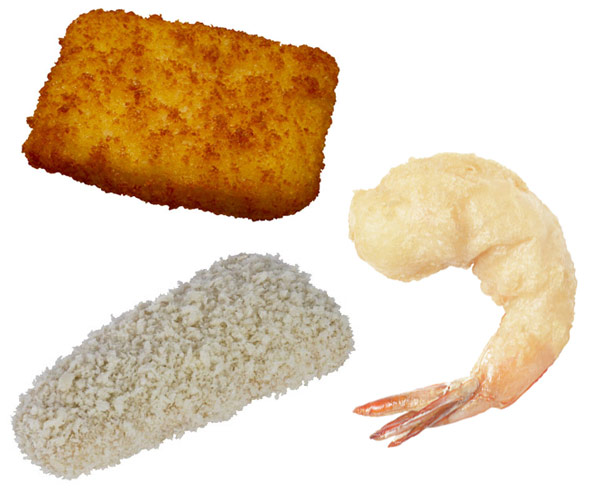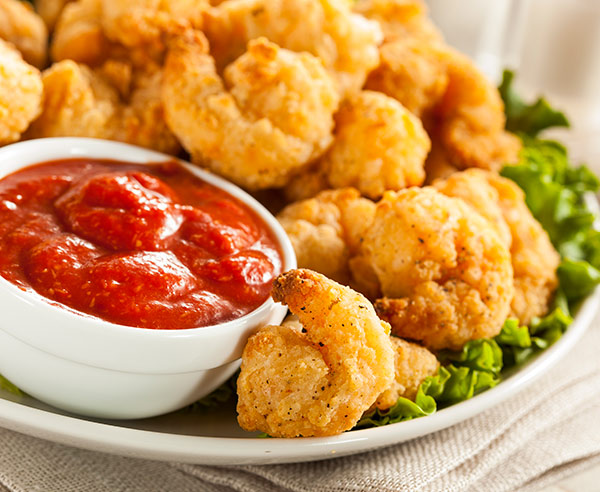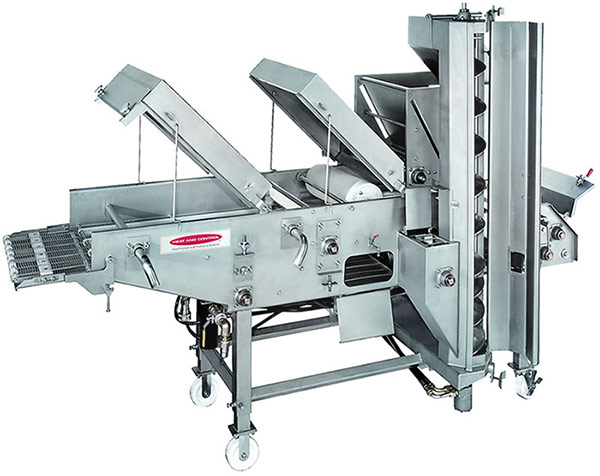Seafood has numerous health benefits and is an essential part of many people’s diets. After harvesting, it’s typically processed and packaged for distribution to retail stores and restaurants. While there are many ways to process seafood, the breaded style remains a consumer favourite, and this market segment is expected to increase significantly in the next five years.

 Breading and battering of seafood products ranges from a very light — to very heavy flour, crumb, or tempura coating. Flour coatings offer a softer coating and bite whereas crumb coatings provide the crispy texture many processors want. Tempura coatings such as the beer batter style coating; create the traditional fish and chip texture. When most of the flavor and the texture will come from the seafood itself; lighter coatings are preferred. But when most of the flavor and the texture will come from the coating; heavier coatings are used.
Breading and battering of seafood products ranges from a very light — to very heavy flour, crumb, or tempura coating. Flour coatings offer a softer coating and bite whereas crumb coatings provide the crispy texture many processors want. Tempura coatings such as the beer batter style coating; create the traditional fish and chip texture. When most of the flavor and the texture will come from the seafood itself; lighter coatings are preferred. But when most of the flavor and the texture will come from the coating; heavier coatings are used.
At a minimum, most seafood coatings consist of a pre-dust, batter, and final breading or light batter, breading, and final batter. Heavier final coatings require multiple passes of coating to allow it to be “built up” on the substrate. This sometimes extends to a three-pass system, if heavier coatings are required.
Building up the coating is an important step because it gives the batter(s) and breading(s) time to properly hydrate and “attach” to the product. If a heavy coating is added too quickly (e.g. in a single step) a coating may not properly adhere, and could fall off during frying, handling, or freezing; resulting in uncoated product.
 The “home-style” look is typically a final appearance, where the surface of the product has a rough appearance, like it was made at home, by hand. A home-style coating is typically a flour-based coating which many consumers find appealing due to its less processed appearance.
The “home-style” look is typically a final appearance, where the surface of the product has a rough appearance, like it was made at home, by hand. A home-style coating is typically a flour-based coating which many consumers find appealing due to its less processed appearance.
This style is achieved by flipping, or rolling, the previously coated substrate, and is most commonly completed in a drum breader for the final application of flour breading. Breading material in the drum breader is then seeded (a small amount of moisture is added, either batter mix or water) to allow the breading to clump slightly. The seeded breading adheres to the surface of the product and this is how the less processed, home-style look is achieved.
The amount of moisture added and the speed at which the product passes through the drum breader varies the intensity of this look, and is how the processor fine-tunes the appearance of the product.
When seafood is processed — it’s not uncommon for the coating to be done while the product is still frozen. When this is the case it can be necessary to run the substrate through a quick water bath to deglaze the product surface to help the coating adhere properly to the product.
It also becomes necessary to closely monitor and control the temperature of the batter — because as it becomes colder over time — the adhesive characteristics change. When this happens; batter applicators (with temperature controlled batter mixers and/or temperature controlled batter tanks) can be facilitated to maintain the optimal temperature, and functional batter characteristics.
 Consumer demand for convenience and healthy options is driving many processors to create new, and different recipes. Industry changing equipment and advanced processing methods are helping them create their special recipe; and achieve more yield, efficiency and safety than before. While the batter and breading process hasn’t changed much over the years – the equipment has.
Consumer demand for convenience and healthy options is driving many processors to create new, and different recipes. Industry changing equipment and advanced processing methods are helping them create their special recipe; and achieve more yield, efficiency and safety than before. While the batter and breading process hasn’t changed much over the years – the equipment has.
A seafood processor still has to apply layers of coating, to facilitate proper adhesion and build up, and create the desired finish. But the design of the equipment used, has seriously leveled up, and speaks directly to customer feedback.
Every facet is of industry-leading equipment is designed to advance the quality of your product – while also achieving cost, and time savings. Batter and breading equipment from Heat and Control is made to follow AMI design principles, which ensures an exceptionally sanitary design, and also makes it functional, reliable, and durable.
These designs seek to remove many of the regular pain points experienced by production managers and operators. For example, durability of the belt (on belted breaders) which was a common issue causing the belt to fail frequently as a result of the pressure of operating, and tension in the belt. Heat and Control have developed a simple but highly effective means of dynamic tensioning (for the main belt) which maintains proper tension — and provides a means of shock absorption, to greatly increase the life of the belt.
A great feature of breaders from Heat and Control is their utilization of a unique lifter conveyor to create the bottom bed of coating. The lifter conveyor replaces the distribution augers used on many other breading applicators. Augers, by nature of their design, tend to compact breading, which in turn can cause jamming. But the lifter conveyor is able to gently lift the breading and deposit it onto the main belt to create the bottom bed. This lifting action prevents jamming, and also allows for varying densities of the bottom bed of coating.
In the past, coating equipment has typically utilized hydraulic drives for all moving components, but it’s become common for customers to request electric drives. It’s much more practical to design and build coating equipment with electric drives; because the current electric drive technology (and sizes) allow for the integration of the coating equipment into a PLC-controlled system — for automatic speed setting/adjustment and performance feedback.
Working with an industry expert is the quickest and simplest way to access industry expertise, on-going support and ensure a great return on investment. The type of product will dictate which equipment is best to use. At Heat and Control, we start by listening to understand your needs, and required outcomes, or what challenges are faced with existing equipment.
We take the time to understand your special recipe, and the desired end product. This includes understanding the type, and amount, of coating required and the type of texture you want for the product. Understanding the characteristics of your ingredients, and how the product will be loaded on the line is very important. With some products, a single-pass line may suffice, but if it’s a heavier coated product, a double or even triple pass line could be necessary. Formed products require linear coating equipment to prevent damage while whole muscle products are able to use drum breaders for the pre-dust and final breading applications.
Want more information on industrial breading of seafood products? We’re committed to innovation and quality which supports your success.